Ultrafast Carrier Relaxation Dynamics in Quantum Confined Non-Isotropic Silicon Nanostructures Synthesized by an Inductively Coupled Plasma Process
Abstract
1. Introduction
2. Materials and Methods
3. Results
3.1. Sample Characterization
3.2. Pump-Probe Measurements
4. Conclusions
Author Contributions
Funding
Acknowledgments
Conflicts of Interest
Appendix A
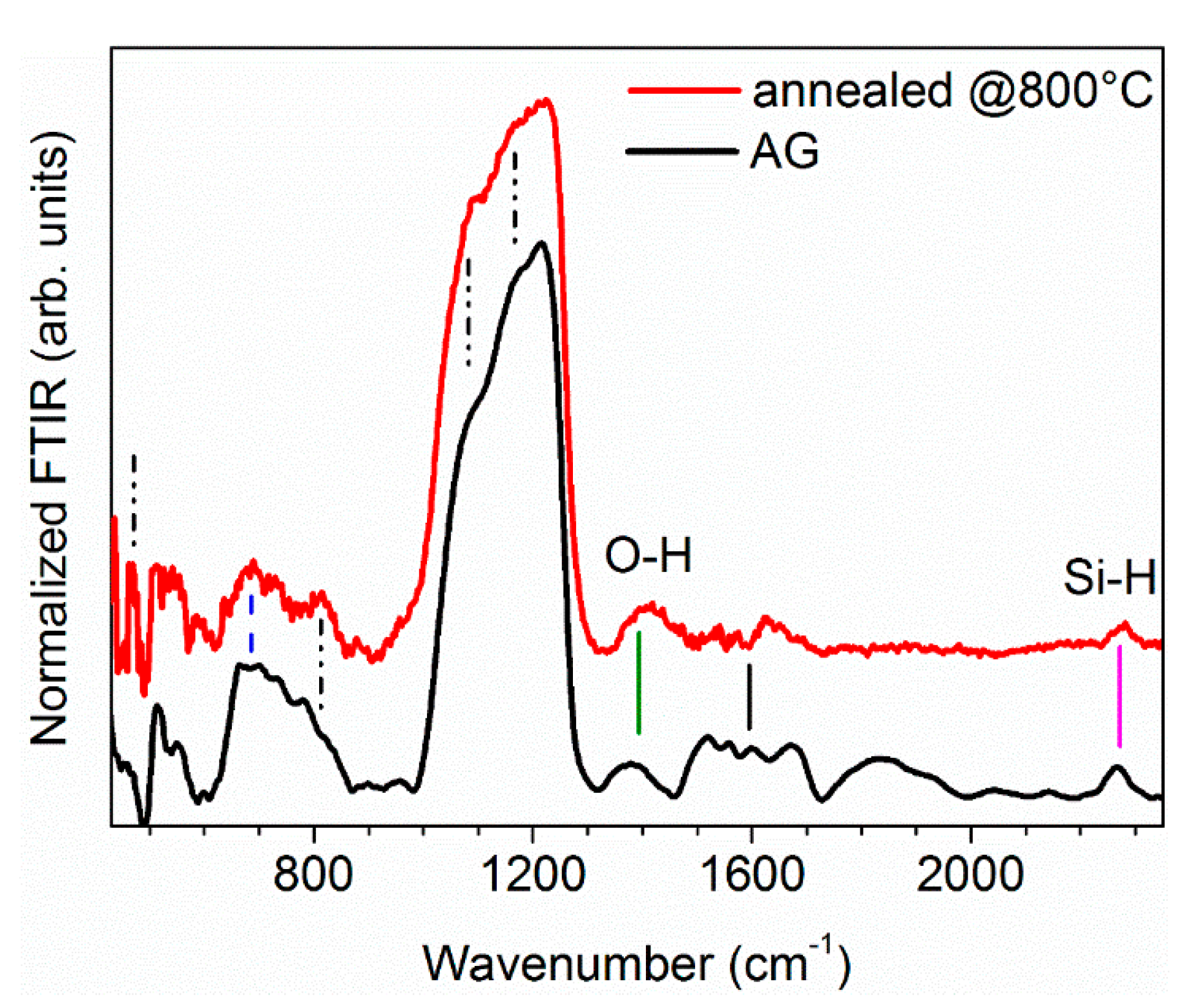
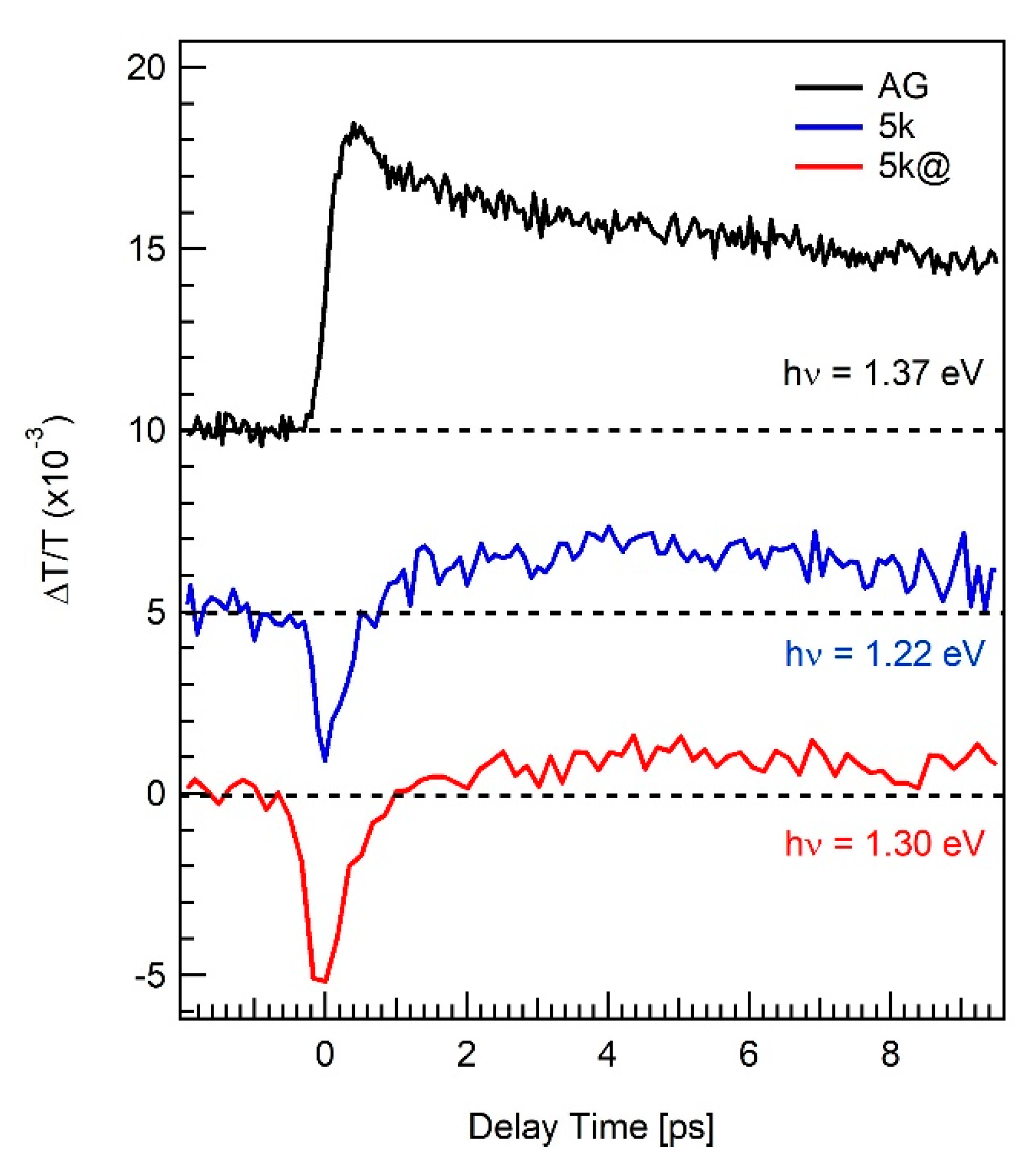
References
- Priolo, F.; Gregorkiewicz, T.; Galli, M.; Krauss, T.F. Silicon nanostructures for photonics and photovoltaics. Nat. Nanotechnol. 2014, 9, 19–32. [Google Scholar]
- Sykora, M.; Mangolini, L.; Schaller, R.D.; Kortshagen, U.; Jurbergs, D.; Klimov, V.I. Size-dependent intrinsic radiative decay rates of silicon nanocrystals at large confinement energies. Phys. Rev. Lett. 2008, 100, 067401. [Google Scholar] [CrossRef]
- Koshida, N. Device Applications of Silicon Nanocrystals and Nanostructures; Springer: New York, NY, USA, 2009; pp. xii, 344. [Google Scholar]
- Servati, P.; Colli, A.; Hofmann, S.; Fu, Y.Q.; Beecher, P.; Durrani, Z.A.K.; Ferrari, A.C.; Flewitt, A.J.; Robertson, J.; Milne, W.I. Scalable silicon nanowire photodetectors. Phys. E 2007, 38, 64–66. [Google Scholar] [CrossRef]
- Al-Taay, H.F.; Mahdi, M.A.; Parlevliet, D.; Jennings, P. Fabrication and Characterization of Solar Cells Based on Silicon Nanowire Homojunctions. Silicon 2017, 9, 17–23. [Google Scholar] [CrossRef]
- Allan, G.; Delerue, C.; Lannoo, M. Nature of luminescent surface states of semiconductor nanocrystallites. Phys. Rev. Lett. 1996, 76, 2961–2964. [Google Scholar] [CrossRef] [PubMed]
- Wolkin, M.V.; Jorne, J.; Fauchet, P.M.; Allan, G.; Delerue, C. Electronic states and luminescence in porous silicon quantum dots: The role of oxygen. Phys. Rev. Lett. 1999, 82, 197–200. [Google Scholar]
- Godefroo, S.; Hayne, M.; Jivanescu, M.; Stesmans, A.; Zacharias, M.; Lebedev, O.I.; Van Tendeloo, G.; Moshchalkov, V.V. Classification and control of the origin of photoluminescence from Si nanocrystals. Nat. Nanotechnol. 2008, 3, 174–178. [Google Scholar] [PubMed]
- Daldosso, N.; Luppi, M.; Ossicini, S.; Degoli, E.; Magri, R.; Dalba, G.; Fornasini, P.; Grisenti, R.; Rocca, F.; Pavesi, L.; et al. Role of the interface region on the optoelectronic properties of silicon nanocrystals embedded in SiO2. Phys. Rev. B 2003, 68, 085327. [Google Scholar]
- De Boer, W.D.A.M.; Timmerman, D.; Dohnalova, K.; Yassievich, I.N.; Zhang, H.; Buma, W.J.; Gregorkiewicz, T. Red spectral shift and enhanced quantum efficiency in phonon-free photoluminescence from silicon nanocrystals. Nat. Nanotechnol. 2010, 5, 878–884. [Google Scholar] [PubMed]
- Brewer, A.; von Haeften, K. In situ passivation and blue luminescence of silicon clusters using a cluster beam/H2O codeposition production method. Appl. Phys. Lett. 2009, 94, 261102. [Google Scholar]
- Vazquez-Valerdi, D.E.; Luna-Lopez, J.A.; Carrillo-Lopez, J.; Garcia-Salgado, G.; Benitez-Lara, A.; Espinosa-Torres, N.D. Compositional and optical properties of SiOx films and (SiOx/SiOy) junctions deposited by HFCVD. Nanoscale Res. Lett. 2014, 9, 422. [Google Scholar] [PubMed]
- Irrera, A.; Artoni, P.; Iacona, F.; Pecora, E.F.; Franzo, G.; Galli, M.; Fazio, B.; Boninelli, S.; Priolo, F. Quantum confinement and electroluminescence in ultrathin silicon nanowires fabricated by a maskless etching technique. Nanotechnology 2012, 23, 075204. [Google Scholar] [CrossRef] [PubMed]
- Artoni, P.; Irrera, A.; Iacona, F.; Pecora, E.F.; Franzo, G.; Priolo, F. Temperature dependence and aging effects on silicon nanowires photoluminescence. Opt. Express 2012, 20, 1483–1490. [Google Scholar] [CrossRef] [PubMed]
- Le Borgne, V.; Agati, M.; Boninelli, S.; Castrucci, P.; De Crescenzi, M.; Dolbec, R.; El Khakani, M.A. Structural and photoluminescence properties of silicon nanowires extracted by means of a centrifugation process from plasma torch synthesized silicon nanopowder. Nanotechnology 2017, 28, 285702. [Google Scholar] [CrossRef] [PubMed]
- Freddi, S.; Fabbri, F.; Cannizzaro, A.; Agati, M.; Dolbec, R.; Drera, G.; Pagliara, S.; Sangaletti, L.; El Khakani, M.A.; Boninelli, S.; et al. High-temperature nitrogen annealing induced bonding states and photoluminescence changes in inductively-coupled plasma torch synthesized silicon nanostructures. J. Appl. Phys. 2020, 128, 024302. [Google Scholar]
- Klimov, V.I.; Schwarz, C.J.; McBranch, D.W.; White, C.W. Initial carrier relaxation dynamics in ion-implanted Si nanocrystals: Femtosecond transient absorption study. Appl. Phys. Lett. 1998, 73, 2603–2605. [Google Scholar] [CrossRef]
- Kar, A.; Upadhya, P.C.; Dayeh, S.A.; Picraux, S.T.; Taylor, A.J.; Prasankumar, R.P. Probing Ultrafast Carrier Dynamics in Silicon Nanowires. IEEE J. Sel. Top. Quant. 2011, 17, 889–895. [Google Scholar] [CrossRef]
- Seo, M.A.; Yoo, J.; Dayeh, S.A.; Picraux, S.T.; Taylor, A.J.; Prasankumar, R.P. Mapping Carrier Diffusion in Single Silicon Core-Shell Nanowires with Ultrafast Optical Microscopy. Nano Lett. 2012, 12, 6334–6338. [Google Scholar] [PubMed]
- Seo, M.A.; Dayeh, S.A.; Upadhya, P.C.; Martinez, J.A.; Swartzentruber, B.S.; Picraux, S.T.; Taylor, A.J.; Prasankumar, R.P. Understanding ultrafast carrier dynamics in single quasi-one-dimensional Si nanowires. Appl. Phys. Lett. 2012, 100, 071104. [Google Scholar] [CrossRef]
- Grumstrup, E.M.; Gabriel, M.M.; Cating, E.M.; Pinion, C.W.; Christesen, J.D.; Kirschbrown, J.R.; Vallorz, E.L.; Cahoon, J.F.; Papanikolas, J.M. Ultrafast Carrier Dynamics in Individual Silicon Nanowires: Characterization of Diameter-Dependent Carrier Lifetime and Surface Recombination with Pump-Probe Microscopy. J. Phys. Chem. C 2014, 118, 8634–8640. [Google Scholar] [CrossRef]
- Gabriel, M.M.; Kirschbrown, J.R.; Christesen, J.D.; Pinion, C.W.; Zigler, D.F.; Grumstrup, E.M.; Mehl, B.P.; Cating, E.E.M.; Cahoon, J.F.; Papanikolas, J.M. Direct Imaging of Free Carrier and Trap Carrier Motion in Silicon Nanowires by Spatially-Separated Femtosecond Pump-Probe Microscopy. Nano Lett. 2013, 13, 1336–1340. [Google Scholar] [CrossRef] [PubMed]
- Wheeler, D.A.; Huang, J.A.; Newhouse, R.J.; Zhang, W.F.; Lee, S.T.; Zhang, J.Z. Ultrafast Exciton Dynamics in Silicon Nanowires. J. Phys. Chem. Lett. 2012, 3, 766–771. [Google Scholar] [CrossRef] [PubMed]
- Sabbah, A.J.; Riffe, D.M. Femtosecond pump-probe reflectivity study of silicon carrier dynamics. Phys. Rev. B 2002, 66, 165217. [Google Scholar] [CrossRef]
- Sangalli, D.; Dal Conte, S.; Manzoni, C.; Cerullo, G.; Marini, A. Nonequilibrium optical properties in semiconductors from first principles: A combined theoretical and experimental study of bulk silicon. Phys. Rev. B 2016, 93, 195205. [Google Scholar] [CrossRef]
- Ledoux, G.; Guillois, O.; Porterat, D.; Reynaud, C.; Huisken, F.; Kohn, B.; Paillard, V. Photoluminescence properties of silicon nanocrystals as a function of their size. Phys. Rev. B 2000, 62, 15942–15951. [Google Scholar] [CrossRef]
- For Further Details on the Tekna Company. Available online: www.tekna.com (accessed on 10 August 2020).
- Agati, M.; Amiard, G.; Le Borgne, V.; Castrucci, P.; Dolbec, R.; De Crescenzi, M.; El Khakani, M.A.; Boninelli, S. Growth Mechanisms of Inductively-Coupled Plasma Torch Synthesized Silicon Nanowires and their associated photoluminescence properties. Sci. Rep. 2016, 5, 37598. [Google Scholar] [CrossRef]
- Agati, M.; Castrucci, P.; Dolbec, R.; El Khakani, M.A.; Boninelli, S. Formation of Hybrid Silicon Nanostructures via Capillary Instability Triggered in Inductively-Coupled-Plasma Torch Synthesized Ultra-Thin Silicon Nanowires. Phys. Status Solidi B 2019, 256, 1800620. [Google Scholar] [CrossRef]
- Qin, Y.; Lee, S.M.; Pan, A.; Gosele, U.; Knez, M. Rayleigh-instability-induced metal nanoparticle chains encapsulated in nanotubes produced by atomic layer deposition. Nano Lett. 2008, 8, 114–118. [Google Scholar] [CrossRef]
- Kobitski, A.Y.; Zhuravlev, K.S.; Wagner, H.P.; Zahn, D.R.T. Self-trapped exciton recombination in silicon nanocrystals. Phys. Rev. B 2001, 63, 115423. [Google Scholar] [CrossRef]
- Ghanta, U.; Ray, M.; Biswas, S.; Sardar, S.; Maji, T.K.; Pal, S.K.; Bandyopadhyay, N.R.; Liu, B.; Hossain, S.M. Effect of phonon confinement on photoluminescence from colloidal silicon nanostructures. J. Lumin. 2018, 201, 338–344. [Google Scholar] [CrossRef]
- Marinopoulos, A.G.; Reining, L.; Rubio, A.; Vast, N. Optical and loss spectra of carbon nanotubes: Depolarization effects and intertube interactions. Phys. Rev. Lett. 2003, 91, 046402. [Google Scholar] [CrossRef] [PubMed]
- Ma, D.D.D.; Lee, S.T.; Shinar, J. Strong polarization-dependent photoluminescence from silicon nanowire fibers. Appl. Phys. Lett. 2005, 87, 033107. [Google Scholar] [CrossRef]
- De Boer, W.; Timmerman, D.; Yassievich, I.; Capretti, A.; Gregorkiewicz, T. Reply to ‘Absence of redshift in the direct bandgap of silicon nanocrystals with reduced size’. Nat. Nanotechnol. 2017, 12, 932–933. [Google Scholar] [CrossRef] [PubMed]
- Luna-López, J.A.; Aceves-Mijares, J.C.-L.M.; Morales-Sánchez, A.; Falcony, C. FTIR and Photoluminescence of Annealed Silicon Rich Oxide films. Superf. Vacío 2009, 21, 11–14. [Google Scholar]
- Morioka, T.; Kimura, S.; Tsuda, N.; Kaito, C.; Saito, Y.; Koike, C. Study of the structure of silica film by infrared spectroscopy and electron diffraction analyses. Mon. Not. R. Astron. Soc. 1998, 299, 78–82. [Google Scholar] [CrossRef]
- Moumni, B.; Jaballah, A.B.; Aouida, S.; Bessaïs, B. Dimers as Fast Diffusing Species for the Aggregation of Oxygen in Boron-Doped Czochralski Silicon: Formation of New Thermal Donors. World J. Condens. Matter Phys. 2012, 2, 6. [Google Scholar] [CrossRef][Green Version]
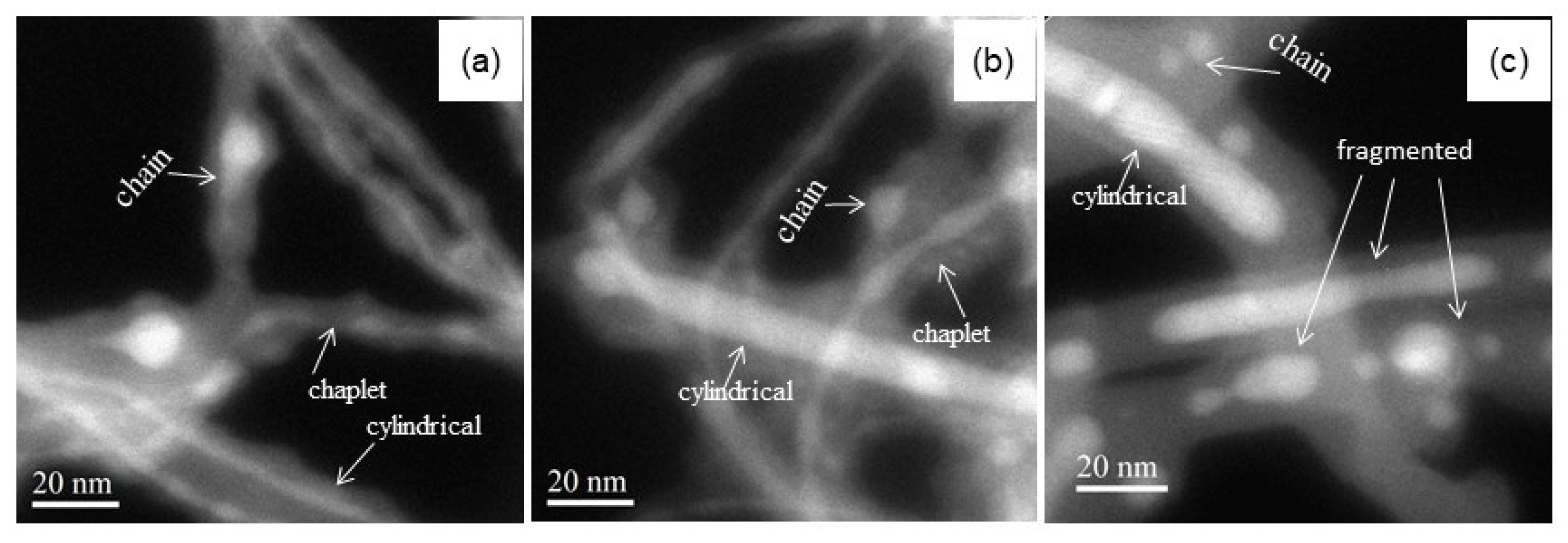
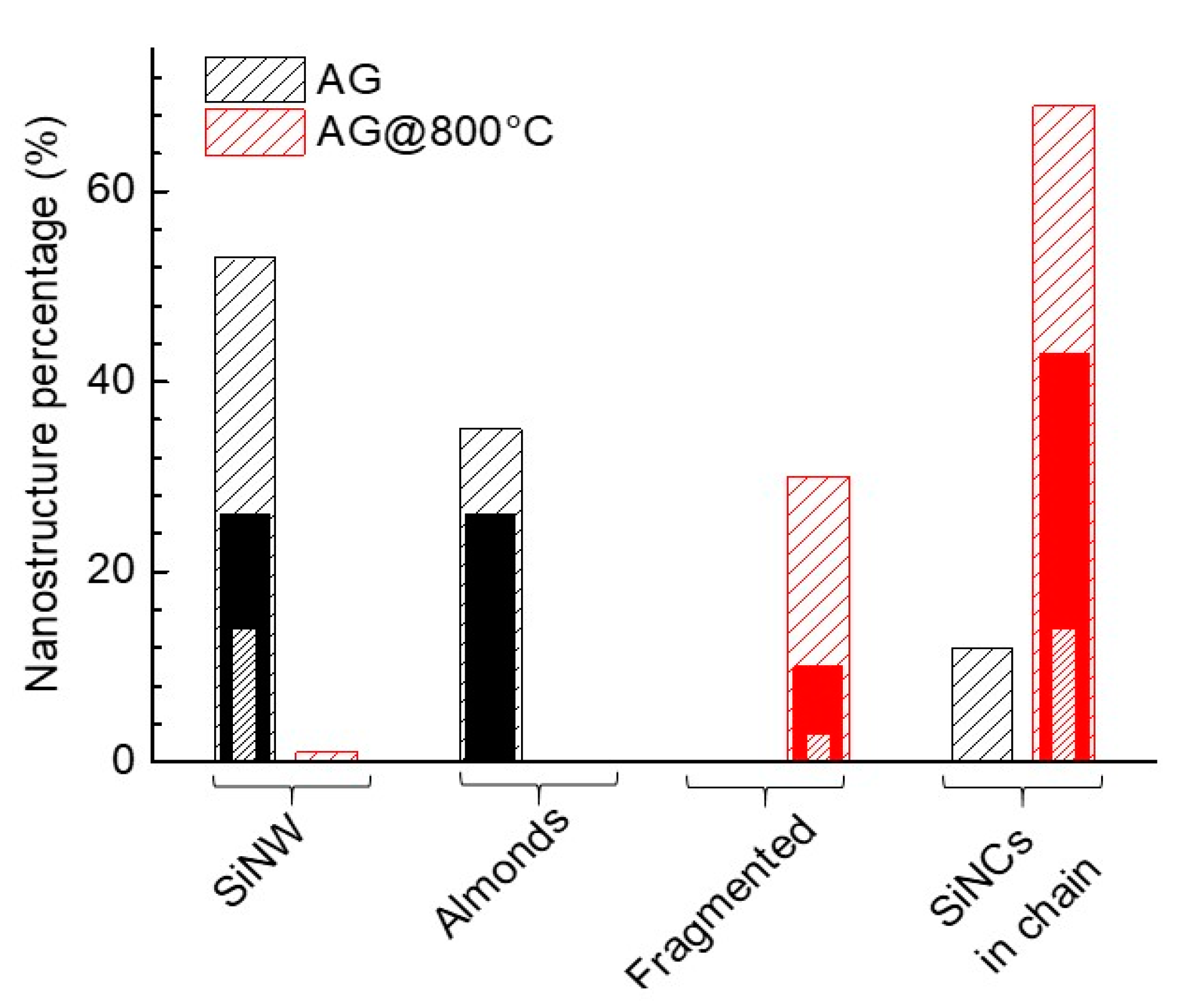
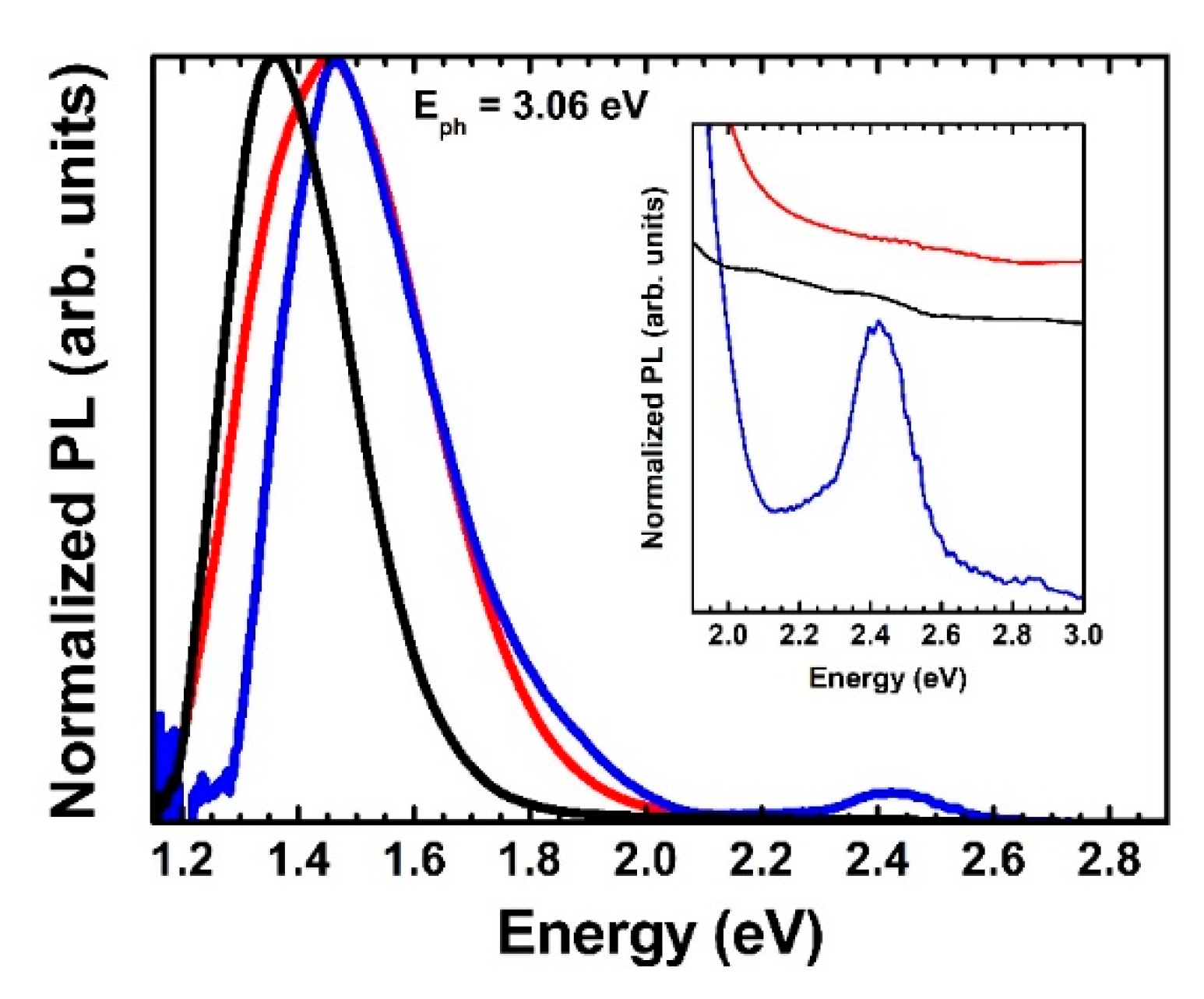
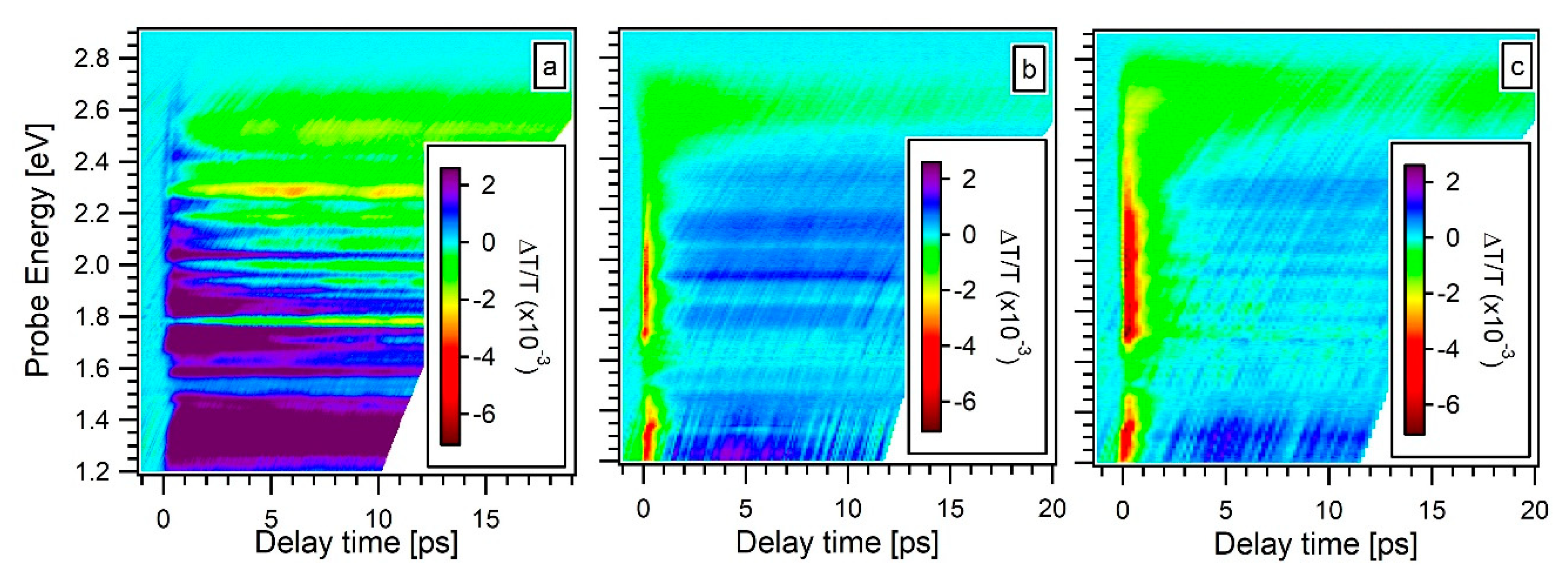
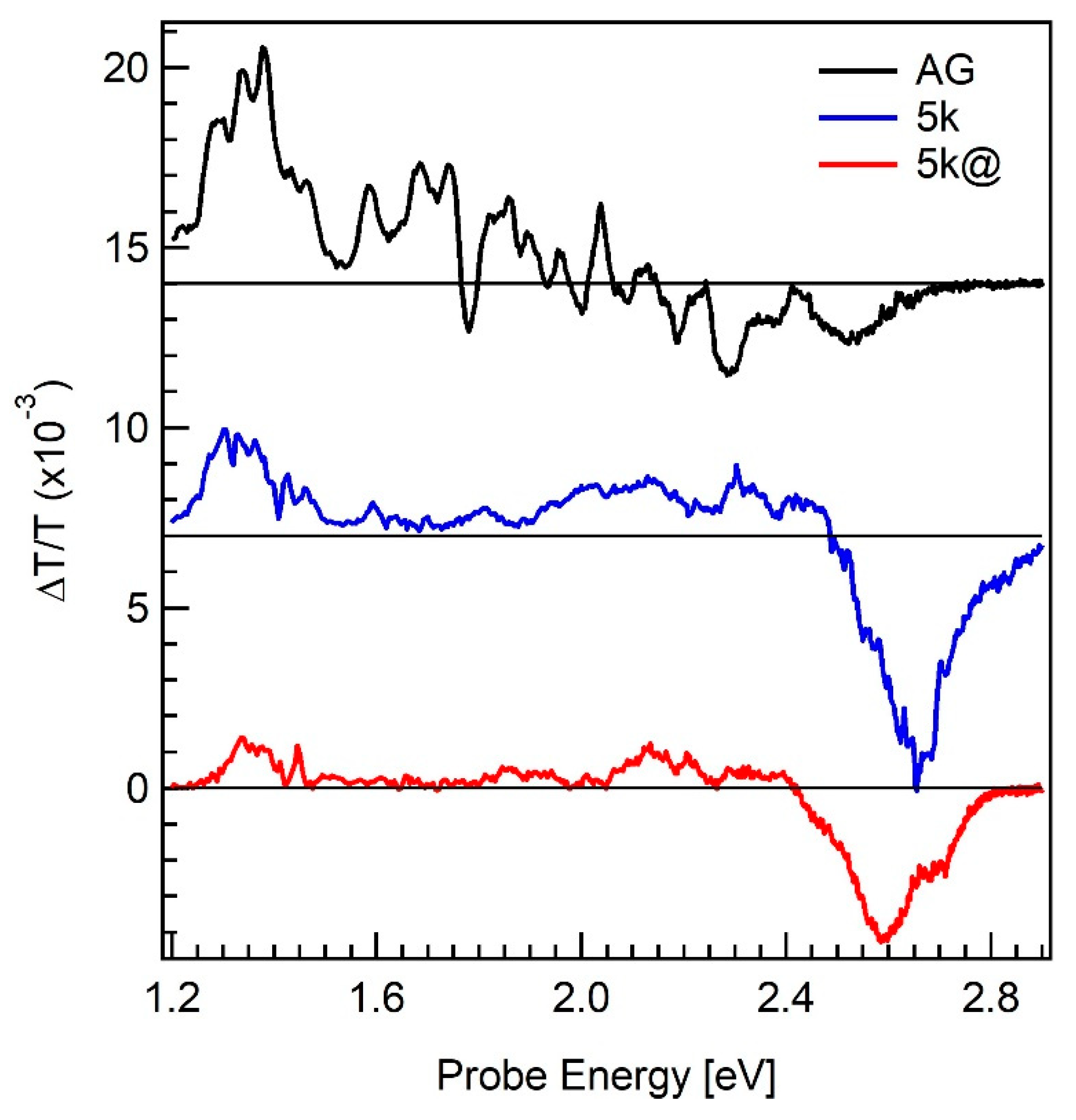
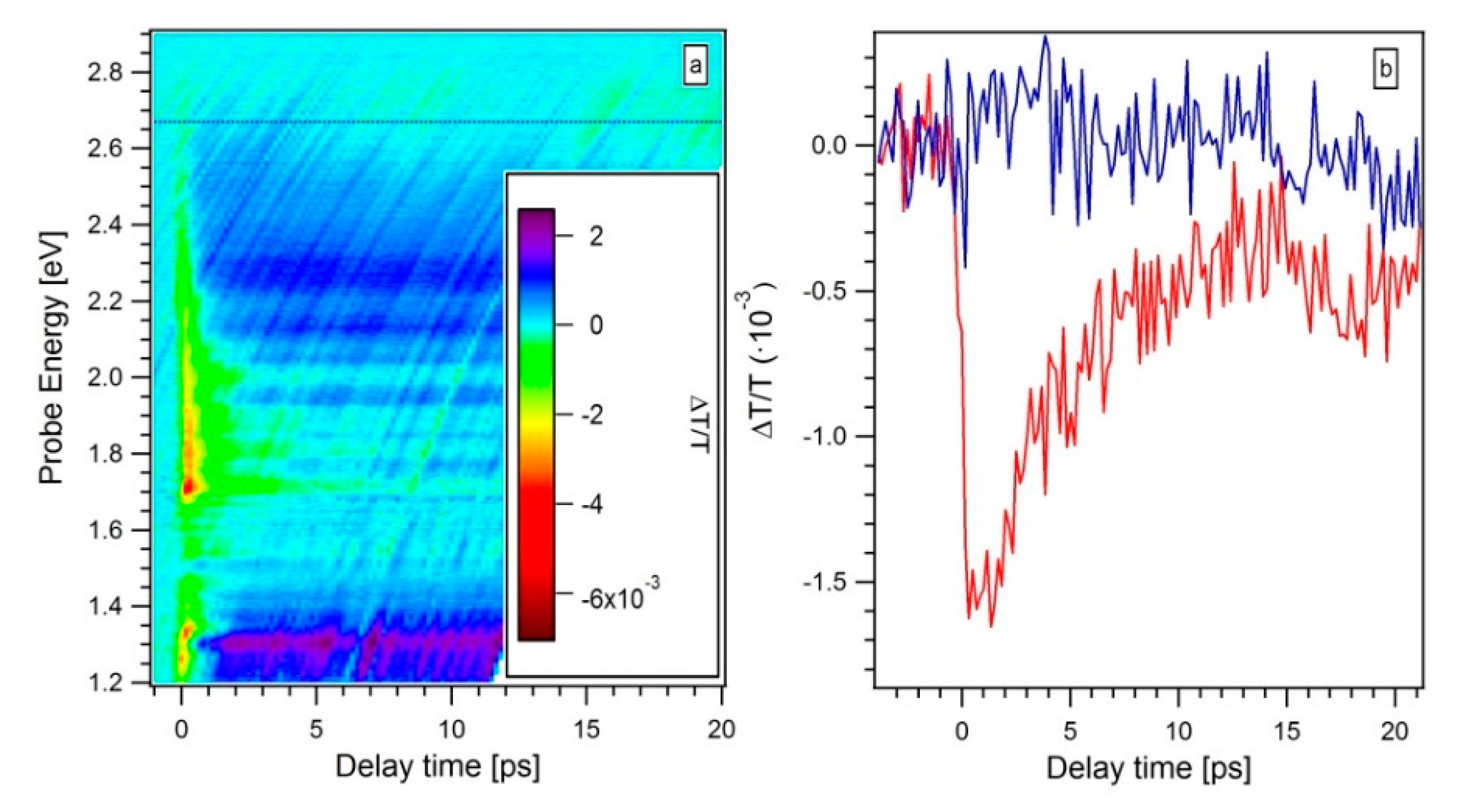
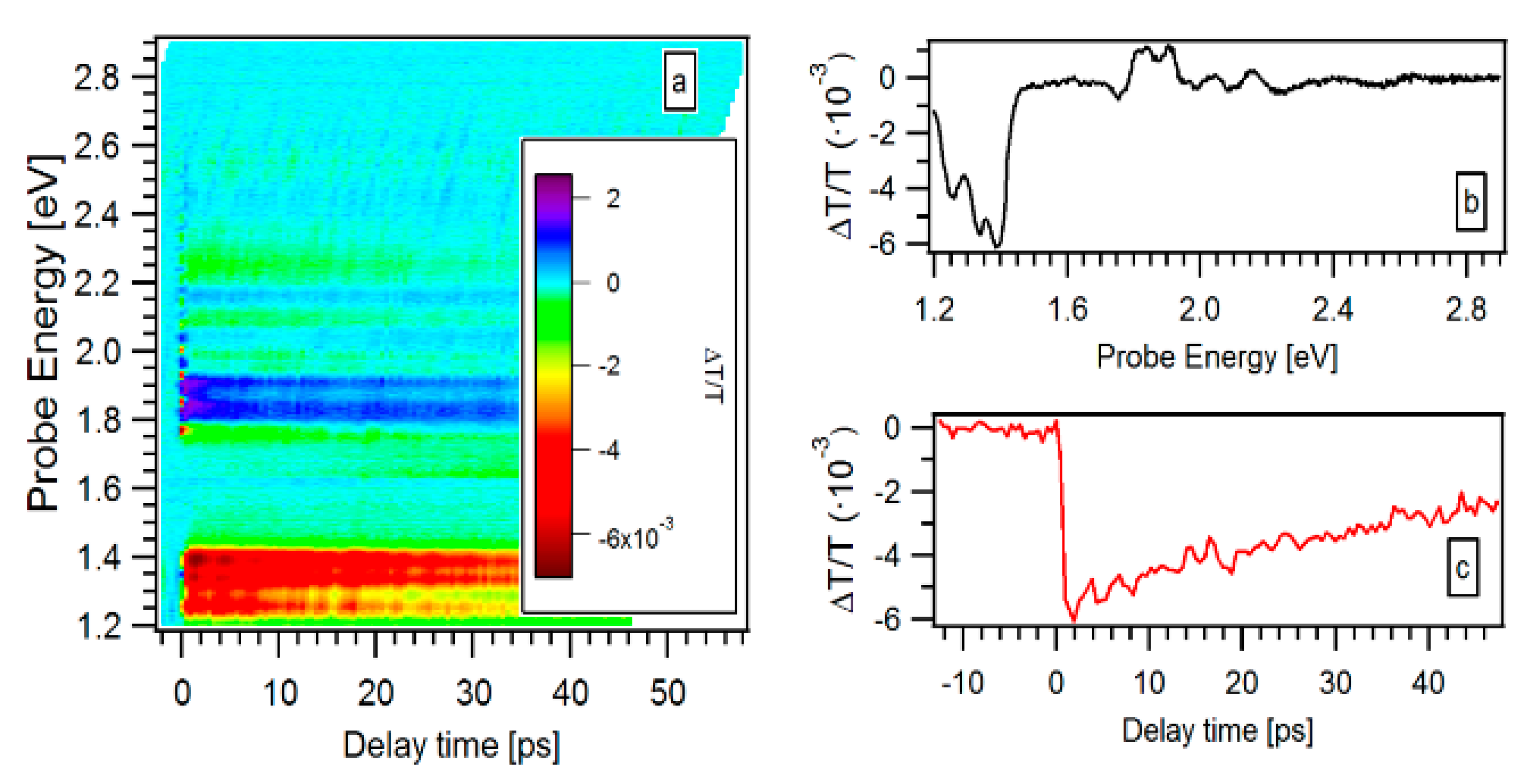
© 2020 by the authors. Licensee MDPI, Basel, Switzerland. This article is an open access article distributed under the terms and conditions of the Creative Commons Attribution (CC BY) license (http://creativecommons.org/licenses/by/4.0/).
Share and Cite
Ponzoni, S.; Freddi, S.; Agati, M.; Le Borgne, V.; Boninelli, S.; Dolbec, R.; El Khakani, M.A.; Pagliara, S.; Castrucci, P. Ultrafast Carrier Relaxation Dynamics in Quantum Confined Non-Isotropic Silicon Nanostructures Synthesized by an Inductively Coupled Plasma Process. Materials 2020, 13, 4267. https://doi.org/10.3390/ma13194267
Ponzoni S, Freddi S, Agati M, Le Borgne V, Boninelli S, Dolbec R, El Khakani MA, Pagliara S, Castrucci P. Ultrafast Carrier Relaxation Dynamics in Quantum Confined Non-Isotropic Silicon Nanostructures Synthesized by an Inductively Coupled Plasma Process. Materials. 2020; 13(19):4267. https://doi.org/10.3390/ma13194267
Chicago/Turabian StylePonzoni, Stefano, Sonia Freddi, Marta Agati, Vincent Le Borgne, Simona Boninelli, Richard Dolbec, My Ali El Khakani, Stefania Pagliara, and Paola Castrucci. 2020. "Ultrafast Carrier Relaxation Dynamics in Quantum Confined Non-Isotropic Silicon Nanostructures Synthesized by an Inductively Coupled Plasma Process" Materials 13, no. 19: 4267. https://doi.org/10.3390/ma13194267
APA StylePonzoni, S., Freddi, S., Agati, M., Le Borgne, V., Boninelli, S., Dolbec, R., El Khakani, M. A., Pagliara, S., & Castrucci, P. (2020). Ultrafast Carrier Relaxation Dynamics in Quantum Confined Non-Isotropic Silicon Nanostructures Synthesized by an Inductively Coupled Plasma Process. Materials, 13(19), 4267. https://doi.org/10.3390/ma13194267







